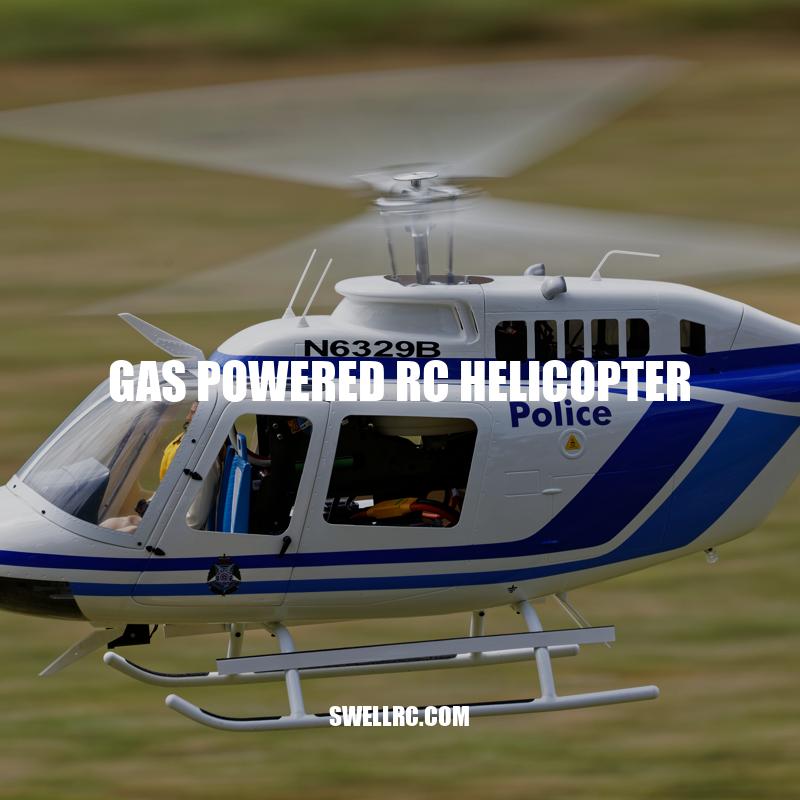Gas-Powered RC Helicopter: Benefits, Selection, and Popular Models
Gas-Powered RC Helicopter: The Ultimate Guide
Remote-controlled helicopters are undoubtedly one of the most exciting radio-controlled devices you can fly. They offer thrill, excitement, and an opportunity to pilot a miniature helicopter. As you progress in your RC helicopter flying skills, you may be interested in exploring gas-powered models. Gas-powered helicopters have a larger engine and fuel tank, allowing them to fly for extended periods. They also have more power and can reach higher speeds than electric-powered helicopters. You can perform stunts, tricks and fly your helicopter further than an electric-powered model. In this guide, we will delve further into the world of gas-powered RC helicopters, discuss their benefits, provide tips on choosing the best gas-powered model for you, and explore the most popular models on the market. With this guide, you’ll have a better understanding of gas-powered RC helicopters and be able to make an informed purchase that fits your preferences, budget and optimizes your flying experience.
Benefits of Gas-Powered RC Helicopters
Fuel Efficiency and Longer Flying Times:
Compared to electric-powered RC helicopters, gas-powered models have larger engines and fuel tanks, allowing them to run for longer without refueling.
- Some gas-powered helicopters consume less fuel, making them more efficient
- Efficient gas helicopters can fly up to 20 minutes without needing a refuel
Powerful Capabilities:
The engines in gas-powered models produce more torque and have a higher RPM range, resulting in a higher power output compared to electric-powered models.
- Fly at higher speeds than electric helicopters
- Lift more weight than electric models
- Improve maneuverability with faster spins
Durable and Reliable:
Gas-powered models are built to handle wear and tear, making them perfect for flying frequently.
- Large size and sturdy construction can withstand crashes better than smaller electric-powered models
- Less heat generated than nitro helicopters, reducing wear and tear on moving parts
Ultimately, the higher weight and larger size of gas-powered helicopters make them more stable in the air, allowing you to perform more advanced maneuvers. Additionally, gas-powered helicopters are comparable in price when compared to some high-end electric models. When considering the benefits, gas-powered helicopters provide a powerful flying experience that enthusiasts crave. Heliguy is a reputable online retailer that provides various options when purchasing a gas-powered RC helicopter.
‘What are the advantages of gas-powered RC helicopters compared to electric-powered models’?
Gas-powered RC helicopters have been the preferred choice of seasoned RC hobbyists for many years. These helicopters rely on gas or nitro fuel as a source of power. But what makes gas-powered RC helicopters so special when compared to their electric-powered counterparts?
One of the main advantages of gas-powered RC helicopters is their flight time. They can fly for longer durations compared to their electric-powered counterparts. This is because gas engines have a larger fuel capacity and consume fuel at a slower rate. Therefore, they can stay in the air for up to 20 minutes or even more.
Additionally, gas-powered RC helicopters are known for their powerful engines. They can attain higher speeds and altitudes than electric models, making them ideal for tricks and acrobatics. Gas-powered engines can also generate high torque, which enables the helicopter to lift heavier loads.
Another advantage of gas-powered RC helicopters is that they are more customizable. Since they have more complex engines, RC enthusiasts can adjust the tuning of the engine to suit their needs. This allows for more flexibility in terms of how the helicopter performs and feels in the air.
Overall, gas-powered RC helicopters offer superior flight times, powerful engines, and greater customization options compared to electric models. While they may require more maintenance and care, the benefits they provide make them the preferred choice for many RC hobbyists.
Gas-powered RC helicopters require regular maintenance to keep them running optimally. Check the fuel lines, filters, and clamps regularly for leaks or cracks. Inspect the engine, bearings, and gears for signs of wear and tear. Use a fuel stabilizer to prolong the lifespan of the fuel and prevent corrosion.
While gas-powered RC helicopters are reliable and durable, they can experience issues from time to time, requiring repairs. Common issues include broken blades, a damaged engine or fuel system components. Replacement parts for gas-powered RC helicopters are widely available online or at hobby shops. Consider upgrading parts for improved performance, such as a better muffler or engine parts.
Repair costs for gas-powered RC helicopters vary depending on the issue and replacement parts required. However, repairing or replacing parts can be more cost-effective than purchasing a new helicopter. Blade replacements can cost between $20 – $50, engine replacements between $150 – $500, and fuel system repairs between $50 – $100. Upgraded parts can cost between $50 – $200+.
It’s important to note that repair costs can be reduced by performing regular maintenance and catching issues early on. If you’re unsure about performing maintenance or repairs on your gas-powered RC helicopter, consider consulting a professional for assistance. Heli-Planet.com is a website dedicated to providing information on maintenance and repairs for RC helicopters, including resources for gas-powered models.
How much do replacement parts for gas-powered RC helicopters cost?
When it comes to gas-powered RC helicopters, replacement parts can be a sensitive topic. Not only different models require different parts, but sometimes it might be difficult to find the right parts you need. However, in general, replacement parts for gas-powered RC helicopters can cost anywhere from a few dollars up to a hundred dollars or more depending on the part that needs to be replaced.
According to experts, common replacement parts for gas-powered RC helicopters include blades, gears, shafts, bearings, and engines. While some of these parts might be more affordable than others, it’s important to remember that investing in high-quality parts can help ensure the longevity and performance of your RC helicopter.
It’s worth noting that the cost of replacement parts can also vary depending on the brand and quality of the parts you’re purchasing. Cheaper parts may seem appealing at first, but in the long run, they can end up costing you more if they’re prone to breaking or don’t fit your helicopter correctly. On the other hand, investing in reputable brands and high-quality parts can save you money and time down the line.
Ultimately, the cost of replacement parts for gas-powered RC helicopters will depend on various factors including the specific parts you need, the quality and brand of the parts, and where you purchase them from. It’s important to do your research and shop around to ensure you’re getting the best bang for your buck.
Flying Tips for Gas-Powered RC Helicopters
Before flying your gas-powered RC helicopter, it’s important to perform a pre-flight check to ensure that everything is in working order. Check the fuel level and ensure that the fuel lines are properly connected. Inspect the blades for any damage or cracks. Check the battery level on your transmitter and ensure that it’s fully charged.
Flying a gas-powered RC helicopter requires some skill. Start slow and gradually increase speed to get a feel for the controls and the helicopter’s movements. Practice hovering in one spot to practice precision and control. Use the tail rotor to control the direction and orientation of the helicopter. Avoid over-controlling the helicopter, as it can lead to instability. Be mindful of the wind direction and adjust your flight accordingly.
While gas-powered RC helicopters can be flown both indoors and outdoors, there are certain factors to consider when flying outdoors. Check the weather forecast and avoid flying in strong winds or rain. Choose a large, open area to fly to avoid obstacles and other hazards. Be mindful of people and animals in the area and avoid flying close to them. Fly at a safe altitude to avoid interfering with other aircraft or objects in the area.
Finding a suitable location to practice flying your gas-powered RC helicopter is important to improve your flying skills and avoid accidents. Many hobby shops have designated areas for flying RC helicopters. Local flying clubs or groups can offer flying lessons and locations to fly at. Empty parking lots or open fields make for great, free outdoor flying locations.
HobbyTron.com is a website that offers a wide selection of gas-powered RC helicopters for sale, as well as tips and resources for flying and maintaining them.
What are some tips for flying gas-powered RC helicopters outdoors?
Flying gas-powered RC helicopters can be a thrilling outdoor activity for hobbyists. However, it requires some skills to operate and maintain the helicopter. Here are a few helpful tips to keep in mind when flying gas-powered RC helicopters outdoors.
1. Find a spacious area: Gas-powered RC helicopters require vast and open spaces for safe flight. Look for an open area with minimal obstacles to avoid crashing or damaging the helicopter.
2. Check the weather conditions: Before taking your helicopter for a spin, check the weather conditions to avoid high winds or heavy rainfall. Flying in unfavorable weather conditions may cause instability and crashes.
3. Familiarize yourself with the controls: Knowing how to operate the helicopter is crucial to avoid crashing. Take time to learn the different controls and features of the helicopter.
4. Keep a maintenance routine: Regular maintenance of the helicopter is essential in ensuring that it functions optimally. Check the fuel levels, battery life, and other essential components before each flight.
5. Stay alert: Always stay focused and attentive when flying your helicopter. Keep an eye on the helicopter’s movement and be ready to take control in case of unexpected changes in the wind or other factors.
By following these tips, you can enjoy flying gas-powered RC helicopters outdoors safely and exhilaratingly.
Maintenance and Care for Gas-Powered RC Helicopters
Proper cleaning and servicing of your gas-powered RC helicopter is important to keep it in good condition and prevent malfunctions.
- Wipe down the helicopter with a soft, damp cloth after each flight to remove dirt and debris
- Gently clean the rotor blades with a soft brush or cloth to remove any dust or debris
- Periodically lubricate the moving parts and bearings with a high-quality lubricant
- Inspect the helicopter for loose or damaged parts and replace them as needed
Storing the Helicopter
If you’re not going to fly your gas-powered RC helicopter for an extended period, proper storage is essential to maintain its condition.
- Store the helicopter in a clean, dry place away from direct sunlight and humidity
- Disconnect the battery to prevent discharging and potential damage
- Remove the fuel from the tank to prevent clogging and damage
- Store the helicopter in its original case or a suitable storage box to protect it from dust and damage
Regular Maintenance
Regular maintenance of your gas-powered RC helicopter is important to ensure that it remains in good condition and safe to fly.
| Task | Frequency |
|---|---|
| Inspect rotor blades for damage or wear | Before each flight |
| Check fuel lines and connectors for leaks or damage | Before eachflight |
| Replace worn or damaged parts | As needed |
| Perform a full maintenance check, including cleaning, lubrication, and inspection | Every 10-15 flights or as recommended by the manufacturer |
RCHelicopter.com is a website dedicated to all things related to RC helicopters, including gas-powered models. The site offers tips and advice on flying and maintaining RC helicopters, as well as a forum for enthusiasts to share information and experiences.
‘What are some tips for storing a gas-powered RC helicopter’?
RC helicopters are a lot of fun, and they require proper maintenance and storage to maintain their longevity. If you’re an avid hobbyist, then you know that when it comes to RC helicopters, their components and parts are sensitive and expensive. Therefore, it’s vital to store your gas-powered RC helicopter the right way. Here are some tips that can help you ensure that your helicopter stays in excellent condition when not in use.
1. Remove the fuel: When your helicopter is not in use, make sure to burn all of the fuel inside the tank completely and turn off its engine. Running the engine dry, or draining it, helps to avoid fuel leftover depositing or evaporating in the carburetor that can lead to clogging and rust issues that may cause damage in the future.
2. Clean the helicopter: Thoroughly clean your helicopter with a soft, damp cloth, and ensure that you pack it in its original box or a plastic container when it’s dry.
3. Store in a cool, dry place: Moisture and heat are two significant factors that damage the helicopter’s critical components, such as the engine seal, frames, and gears. Therefore, store it in a place with a moderate temperature and away from direct sunlight to safeguard it from the elements.
4. Disconnect the battery: If your helicopter has a rechargeable battery, ensure that you remove it before storing it. Leaving the battery connected can cause the battery to drain, and damaging both the battery and helicopter.
5. Regular Inspection: Carry out regular checks on your helicopter to ensure that it hasn’t been damaged or that no dust or debris has gotten inside that might obstruct the moving parts.
In conclusion, proper storage of your gas-powered RC helicopter helps to protect your investment and maintain its longevity for years to come. Follow these tips, and your helicopter will be ready to fly whenever you’re ready to take it for a spin.
Gas-powered RC helicopters are an exciting and challenging way to experience the thrill of flying. With their power and speed, they offer an unparalleled level of control and maneuverability. While they require more maintenance and care than electric-powered models, the benefits make the extra effort worthwhile. Not only do they provide longer flying times and improved durability, but they’re also perfect for advanced pilots looking for a challenge.
When purchasing a gas-powered RC helicopter, be sure to research the different models available and read reviews from other pilots. This will help you determine which model will best suit your needs and level of experience. Remember to properly maintain and care for your helicopter to keep it in good condition and prevent malfunctions.
Whether you’re an experienced remote-controlled helicopter pilot or a beginner looking for a new challenge, a gas-powered RC helicopter may be the perfect choice. With their power, speed, and endurance, they provide an exhilarating flying experience that’s hard to match. So why not start your gas-powered RC helicopter adventure today? With the right research, preparation, and care, you’ll be on your way to mastering this exciting hobby!



